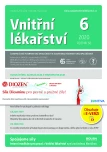Anaphylaxis – acute and long-term management
Authors:
Martina Vachová
Authors‘ workplace:
Ústav imunologie a alergologie, Lékařská fakulta v Plzni, Univerzita Karlova
Published in:
Vnitř Lék 2020; 66(6): 335-339
Category:
Main Topic
Overview
Anaphylaxis is a serious, potentially life‑threatening condition, and all healthcare professionals should be aware of it. Prompt recognition of anaphylaxis signs and early initiation of adequate treatment are essential for successful acute management. The first‑line treatment is the administration of intramuscular adrenalin, followed by other interventions. Patients should be moni ‑ tored after recovery for possible biphasic reaction. Before discharge, the individual risk of further reaction should be assessed and where appropriate an adrenalin auto‑injector should be prescribed. Allergy specialist follow‑up is essential for the identification of possible triggers and cofactors. Elimination of these factors reduces the risk of future reactions. Useful preventive measure is allergen immunotherapy, which is definitely indicated in patients with anaphylaxis induced by an insect sting.
Keywords:
anaphylaxis – trigger – cofactor – adrenaline auto‑injector – allergen immunotherapy
Sources
1. Muraro A, Roberts G, Worm M, et al. Anaphylaxis: guidelines from the European Academy of Allergy and Clinical Immunology. Allergy. 2014; 69(8): 1026–1045.
2. Reber LL, Hernandez JD, Galli SJ. The pathophysiology of anaphylaxis. J Allergy Clin Immunol. 2017; 140(2): 335–348.
3. Petrů V. Anafylaxe – život ohrožující reakce. Postgrad Med 2019; 21(4): 277–282.
4. Muraro A, Lemanske Jr. RF, Castells et al. Precision medicine in allergic disease-food allergy, drug allergy, and anaphylaxis ‑PRACTALL document of the European Academy of Allergy and Clinical Immunology and the American Academy of Allergy, Asthma and Immunology. Allergy 2017; 72 : 1006–1021.
5. Panesar SS, Javad S, de Silva D, et al. The epidemiology of anaphylaxis in Europe: a systematic review. Allergy. 2013; 68 : 1353–1361.
6. Lee S, Hess EP, Lohse C, et al. Trends, characteristics, and incidence of anaphylaxis in 2001–2010: a population‑based study. J Allergy Clin Immunol. 2017; 139 : 182–188.
7. Ruiz Oropeza A, Bindslev ‑Jensen C, Broesby ‑Olsen S, et al. Patterns of anaphylaxis after diagnostic workup: A follow‑up study of 226 patients with suspected anaphylaxis. Allergy. 2017; 72 : 1944–1952.
8. Grabenhenrich LB, Dölle S, Moneret ‑Vautrin A, et al. Anaphylaxis in children and adolescents: The European Anaphylaxis Registry. J Allergy Clin Immunol. 2016; 137(4): 1128–1137.
9. Simons FE, Ardusso LR, Bilò MB, et al. World allergy organization guidelines for the assessment and management of anaphylaxis. World Allergy Organ J. 2011; 4(2): 13–37.
10. Ellis AK, Day JH. Incidence and characteristics of biphasic anaphylaxis: a prospective evaluation of 103 patients. Ann Allergy Asthma Immunol. 2007; 98(1): 64–69.
11. Akin C. Mast cell activation syndromes. J Allergy Clin Immunol. 2017; 140(2): 349–355.
12. Sala‑Cunill A, Cardona V, Labrador ‑Horrillo M, et al. Usefulness and limitations of sequential serum tryptase for the diagnosis of anaphylaxis in 102 patients. Int Arch Allergy Immunol. 2013; 160(2): 192–199.
13. Petrů V. Doporučený postup léčby anafylaktické reakce – aktualizace 2019. Alergie 2019; 21(3): 216–219.
14. Worm M, Francuzik W, Renaudin JM, et al. Factors increasing the risk for a severe re ‑ action in anaphylaxis: An analysis of data from The European Anaphylaxis Registry. Allergy. 2018; 73(6): 1322–1330.
15. Vachová M. Alergie na blanokřídlý hmyz. Postgrad Med 2019; 21(4): 291–296.
16. Doporučení výboru České společnosti alergologie a klinické imunologie k použití adrenalinového autoinjektoru. Alergie 2018; 20(4): 260.
17. Ellis BC, Brown SG. Parenteral antihistamines cause hypotension in anaphylaxis. Emerg Med Australas. 2013; 25(1): 92–93.
18. Bilò MB, Cichocka ‑Jarosz E, Pumphrey R, et al. Selfmedication of anaphylactic reactions due to Hymenoptera stingsan EAACI Task Force Consensus Statement. Allergy. 2016; 71(7): 931–943.
19. Vachová M. Alergie na včelí a vosí jed. Remedia 2020; 30 : 68–70.
20. Vachová M, Panzner P, Malkusová I, et. al. Utility of laboratory testing for the diagnosis of Hymenoptera venom allergy. Allergy Asthma Proc. 2016; 37(3): 248–255.
21. Vachová M, Panzner P, Kopač P, et al. Routine clinical utility of honeybee venom allergen components. J Allergy Clin Immunol Pract. 2018; 6(6): 2121–2123.
22. Sturm GJ, Varga EM, Roberts G, et al. EAACI guidelines on allergen immunotherapy: Hymenoptera venom allergy. Allergy. 2018; 73(4): 744–764.
23. Bělohlávková S. Potravinová alergie v roce 2019. Postgrad Med 2019; 21(4): 283–289.
Labels
Diabetology Endocrinology Internal medicineArticle was published in
Internal Medicine

2020 Issue 6
Most read in this issue
- Myocardial infarction or broken heart syndrome?
- Gastrointestinal tract involvement in mixed connective tissue disease (Sharp syndrome)
- Food allergy and intolerance
- Complement deficiencies
